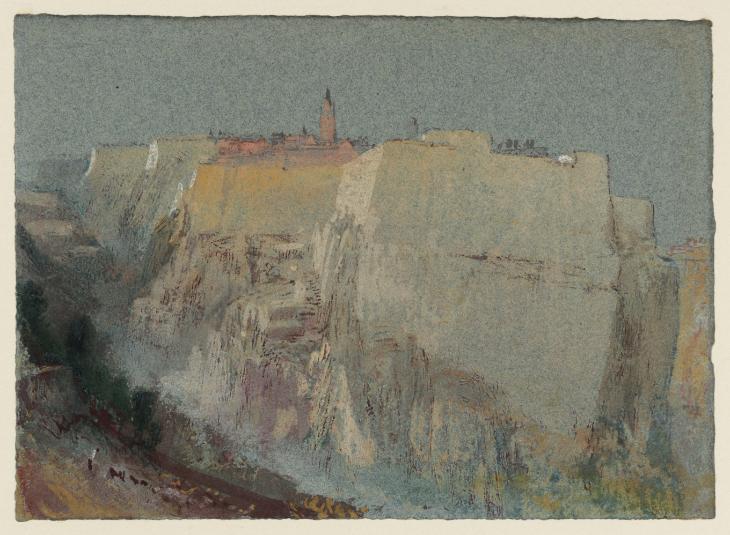Joseph Mallord William Turner The Citadel of Saint-Esprit, Luxembourg c.1839
Joseph Mallord William Turner,
The Citadel of Saint-Esprit, Luxembourg
c.1839
Joseph Mallord William Turner 1775–1851
The Citadel of Saint-Esprit, Luxembourg c.1839
D20248
Turner Bequest CCXXI O
Turner Bequest CCXXI O
Gouache, pen and ink and watercolour on blue wove paper, 140 x 194 mm
Blind-stamped with Turner Bequest monogram bottom right
Stamped in black ‘CCXXI O’ bottom right
Blind-stamped with Turner Bequest monogram bottom right
Stamped in black ‘CCXXI O’ bottom right
Accepted by the nation as part of the Turner Bequest 1856
Exhibition history
1904
National Gallery, London, various dates to at least 1904 (190, as ‘Luxembourg?’).
1939
Aberystwyth, ?November 1939–1939 (no catalogue; 9).
1939
Grande Saison internationale de l’eau, Liège, May–September 1939 (9).
1959
Turner Watercolours from the British Museum, Luxembourg State Museum, June–July 1959 (no catalogue).
1970
Turner: Watercolours Lent by the British Museum, Musée Provisoire d’Art Moderne, Brussels, November 1970–January 1971 (36).
1982
J.M.W. Turner Watercolors from the British Museum, Georgia Museum of Art, University of Georgia, Athens, March–May 1982, Museum of Fine Arts, Houston, May–July 1982 (49, reproduced as Luxembourg).
1984
J.M.W. Turner in Luxembourg and its neighbourhood, Musée de l’Etat, Luxembourg, March–April 1984 (3, reproduced, and in colour [p.[37] as Vue de Luxembourg: la citadelle du Saint-Espirit, les bastions Louis et Beck).
1991
Turner’s Rivers of Europe: The Rhine, Meuse and Mosel, Tate Gallery, London, September 1991–January 1992, Musée Communal d’Ixelles, Brussels, February–April 1992 (121, reproduced, and in colour [p.92]).
1995
J.M.W. Turner: The Luxembourg Watercolours: Collections de la Tate Gallery, Londres et du Musée national d’histoire et d’art, Luxembourg, Musée national d’histoire et d’art, Luxembourg, January–February 1995 (3, reproduced in colour as Vue de Luxembourg: la citadelle du Saint-Espirit, les bastions Louis et Beck).
2007
J.M.W. Turner, National Gallery of Art, Washington, October 2007–January 2008, Dallas Museum of Art, February–May, Metropolitan Museum of Art, New York, June–September (109, reproduced in colour).
References
1904
E.T. Cook and Alexander Wedderburn eds., Library Edition: The Works of John Ruskin: Volume XIII: Turner: The Harbours of England; Catalogues and Notes, London 1904, pp.386, 616 no.190, as ‘Luxembourg?’.
1909
A.J. Finberg, A Complete Inventory of the Drawings of the Turner Bequest, London 1909, vol.II, p.689, as ‘Luxembourg (?)’.
1975
Joseph R. Goldyne, J.M.W. Turner: Works on Paper from American Collections, exhibition catalogue, University Art Museum, Berkeley, California 1975, p.216 no. 79.
1984
Gérard Thill, Jean-Claude Muller and Jean Luc Koltz, J.M.W. Turner in Luxembourg and its neighbourhood, exhibition catalogue, Musée de l’Etat, Luxembourg 1984, pp.13, 24, and note 33, [p.31], 29, and note 41, [p.31].
1991
Cecilia Powell, Turner’s Rivers of Europe: The Rhine, Meuse and Mosel, exhibition catalogue, Tate Gallery, London 1991, p.174 no.121 reproduced.
2007
Ian Warrell (ed.), Franklin Kelly and others, J.M.W. Turner, exhibition catalogue, National Gallery of Art, Washington 2007, p.129, 156 no.109 reproduced in colour.
In this drawing Turner communicates the colossal scale of Luxembourg’s Bock plateau which towers on three sides over the Alzette River. Saint-Esprit fortress stands atop the Bock, the mighty citadel’s foundations appearing seamlessly to merge into the promontory to create one vast and perpendicular mass of rock. To the left of the citadel is the seventeenth-century Jesuit Church of St Michael rendered in delicate line and highlighted in a pale coral pink. Further to the left are the two bastions of Beck and Louis.
In the foreground at left, on a steep gradient leading to the river, stands a tiny figure suggested with the briefest of means: two short dashes, one brown and one white for the body, with a dot of brown for the head. A small flock, perhaps of goats or sheep, gathers before the figure. The addition of the diminutive man and his tiny animals is surely a device to mark differences in scale: the citadel appears simply gigantic in comparison, its dimensions amplified almost beyond belief. Indeed, Turner’s manipulation, his exaggeration, of scale in this drawing led the art critic John Ruskin (1819–1900) to describe it as ‘Probably the grandest drawing of this date’.1
The gouache is based on pencil sketches in the Givet, Mézières, Verdun, Metz, Luxemburg and Trèves sketchbook of the same date (Tate D28228–D28229; Turner Bequest CCLXXXVIII 32 a–33).
The Fogg Art Museum at Cambridge, Massachusetts owns a copy of this work produced by William Ward (1829–1908), who was one of Ruskin’s approved protégés.2
Verso:
Inscribed in chalk or white gouache ‘22’ at centre towards right; inscribed in pencil ‘19b’ and ‘34 b’ at centre towards top left; stamped in black with Turner Bequest monogram and ‘CCXXI O’ at bottom centre and inscribed in pencil ‘CCXXI O’ at bottom towards right.
Alice Rylance-Watson
June 2013
How to cite
Alice Rylance-Watson, ‘The Citadel of Saint-Esprit, Luxembourg c.1839 by Joseph Mallord William Turner’, catalogue entry, June 2013, in David Blayney Brown (ed.), J.M.W. Turner: Sketchbooks, Drawings and Watercolours, Tate Research Publication, November 2014, https://www

